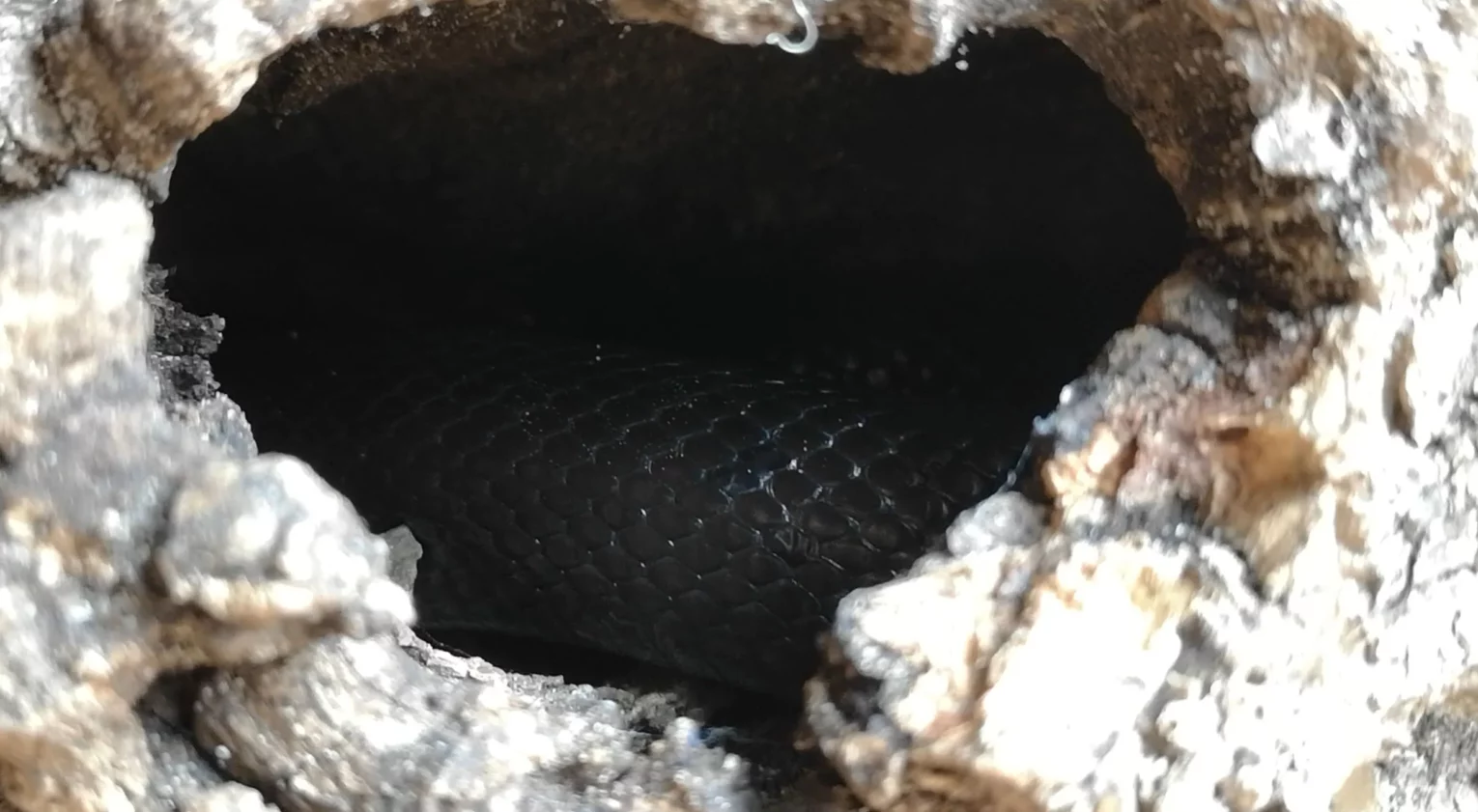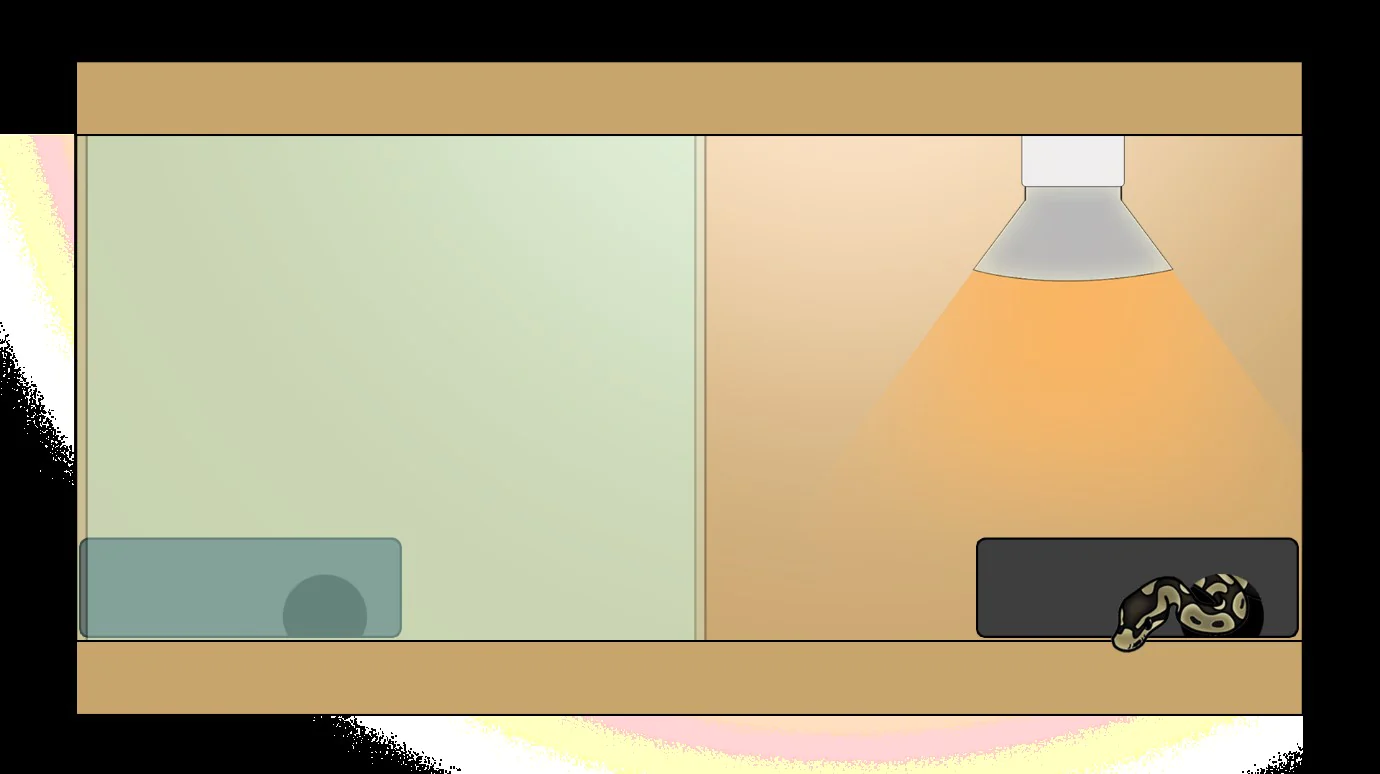Snakes are drawn to tight spaces, and understanding this preference can help in creating a suitable environment for them. This behavior has to do with their innate need for safety and security.
Let’s imagine for a moment: we’ve all seen a snake nuzzling itself into the narrowest cork bark tube or hiding under its water bowl in its enclosure. But why do snakes have such a fondness for tight spots as opposed to any other concealed area? The reason is not merely arbitrary but grounded in interesting biological principles.
The phenomenon driving this behavior is known as thigmotaxis. In simple terms, thigmotaxis refers to an organism’s movement towards or away from an object that provides a mechanical stimulus. This can be observed in various creatures, including snakes, and it’s essentially a survival instinct. When an organism is in an open space, it often instinctively stays close to walls for security – this is thigmotaxis at play.
For snakes, thigmotaxis involves seeking an area that’s so confined that the mechanical stimuli from the surrounding environment give them a sense of security. These stimuli could be the pressure exerted on their body from all sides, which signals to the snake that they are in a place where potential predators can’t easily reach them. Therefore, a tighter space provides a greater sense of security and protection from potential threats.
If we think about it, this isn’t an entirely alien concept to us humans either. When faced with a potentially dangerous or frightening situation, we often instinctively put our back to a wall. We do this because it eliminates any possibility of threats approaching from behind, hence making us feel safer.
Therefore, when housing snakes, understanding their attraction to tight spaces can be crucial. Creating an environment that caters to this natural inclination towards thigmotaxis can make a significant difference in how secure and comfortable your snake feels in its habitat. Offering options like narrow hideouts or enclosed spaces can contribute greatly to your snake’s overall sense of security and well-being.

Thigmotaxis, the propensity of an organism to seek out or avoid certain mechanical stimuli, is a phenomenon that is not exclusive to snakes but is also observed in a range of organisms, from mice to humans. What is particularly intriguing is that providing more options for security seems to contribute to an organism’s ability to relax more effectively.
However, in the snake-keeping hobby, this concept is often misinterpreted or applied incorrectly. Certain approaches to snake keeping, born out of varying beliefs within the community, may not be optimal for the snake’s welfare, and we’ll discuss some research studies related to this later.
Many snake keepers, understanding the need for snakes to feel secure in tight spaces, have defaulted to keeping them in highly enclosed areas like racks or tubs. They surmise that doing so satisfies the snake’s security requirements. But this presumption, while seemingly logical, can lead to a series of larger issues and overall decreased welfare for the snake.
You might point out that numerous keepers successfully maintain their snakes in such enclosures and that those snakes feed, defecate, grow, and even reproduce. In many people’s perspectives, these are signs of successful snake keeping. However, it’s important to realize that these are just basic benchmarks of care, and meeting them doesn’t necessarily mean the snake’s conditions are optimal.
For instance, snakes have been discovered breeding in highly stressful conditions such as being confined in transport bags. This doesn’t imply that the conditions are ideal. Instead, it’s a testament to the snake’s strong survival and reproductive instincts.
Many keepers are mindful of avoiding anthropomorphism, which is attributing human emotions to animals, like saying, “my corn snake loves cuddles”. This fear of being accused of anthropomorphism can lead some to swing to the other extreme and fall into mechanomorphism, perceiving the snake as nothing more than a machine-like entity, which can be just as detrimental.
On the other hand, providing a large enclosure isn’t an automatic guarantee of ideal conditions either. It’s commendable that many keepers, recognizing the welfare issues associated with rack systems, strive to provide larger habitats. These larger enclosures allow for overhead heating, UVB lighting, greater thermal gradients, microclimate creation, and ultimately, more space for the snake.
Yet, the way this larger enclosure is set up is crucial. Some keepers might only provide one or two hiding spots: a conventional rule suggests one at the cool end and one at the hot end of the enclosure. While this approach is a step in the right direction, it misses a crucial point. If the space between the two hides is left barren, it could leave the snake feeling exposed, detracting from the overall comfort and security of its habitat.

In a barren enclosure, a snake may find itself prioritizing security over thermoregulation along the temperature gradient. This means it might choose to stay hidden rather than risk exposure by venturing out to adjust its body temperature, even when doing so is crucial for its well-being.
So, what’s the optimal approach to housing a snake? The key lies in cluttering the enclosure. This might seem counterintuitive at first, but it creates a more suitable environment for the snake’s natural behavior and needs. Adding visual breaks, hides, and tunnels provides the snake with ample cover to traverse the thermal gradient unseen, should it wish to.
One might wonder, “Why would I want to do that? I want to see my snake. If the enclosure is cluttered, I’ll hardly ever see it.” This is a perfectly reasonable concern. However, it’s important to remember that we’re aiming for an environment that caters to the snake’s natural instincts and needs, which includes their need for security and stealth while moving around. This arrangement ensures the snake feels safe and secure, which ultimately leads to a healthier and happier pet.

It may seem counterintuitive, but providing your pet snake with a variety of secure hiding places can actually result in seeing the animal more frequently. The snake tends to be more confident and active when it has multiple options for shelter and security.
There is scientific evidence supporting this observation. For instance, one study involving juvenile corn snakes produced intriguing results. The researchers divided the snakes into two groups: one group was kept in enclosures enriched with various hiding spots, and the other in less cluttered enclosures. The results revealed that the snakes housed in the uncluttered enclosures spent most of their time hidden. In contrast, those in the cluttered enclosures were more often visible, changing their hiding spots and exploiting different elevations in the enclosure. This behavior is attributed to the ability of these snakes to thermoregulate more freely while remaining hidden due to the amount of available cover. Unlike the snakes in the non-cluttered group, they didn’t need to stay in one place because they had multiple secure options, hence they were out and visible more often.
In another study comparing black rat snakes in enriched enclosures to those in minimal enclosures over an eight-month period, the results were equally fascinating. All variables such as temperature and food were kept identical for both groups. The snakes in the enriched enclosures not only grew significantly larger in length and weight—possibly due to increased opportunities for exercise and better muscle development—but they also performed better when eating live prey. They adapted more quickly to new situations outside of the enclosure, and they were faster at learning trials where they had to locate a hole within a set time. These enriched snakes demonstrated superior cognitive and physical abilities, probably because the complex environment demanded more from them in terms of navigation and problem-solving.
These findings lead to an important question: If a snake thrives both cognitively and physically in a more complex environment, shouldn’t we aim to provide that? The answer is an emphatic yes. It underscores that snake husbandry involves more than just feeding and breeding—it’s about creating an environment that promotes physical health and cognitive stimulation.
Achieving this complex environment might involve the inclusion of elements such as UVB lights, near infra-red emitting heat lamps, variations in humidity, and so on. These considerations are backed by scientific studies and can substantially improve the quality of life for your pet snake. But discussing each of these elements in detail warrants a separate conversation or set of videos, which are already available for your reference.
